ITSU 1001 Project: Supercomputer System for Flight Management
VerifiedAdded on 2023/04/23
|13
|3274
|325
Project
AI Summary
This project explores the application of a supercomputer system, specifically the Tianhe-2A, within a Flight Management System (FMS) for modern airliners. It details the FMS components, including the Flight Management Computer (FMC), Control Display Unit (CDU), and their roles in automating in-flight tasks, reducing pilot workload, and managing flight plans. The project discusses the supercomputer's specifications, navigational capabilities, and integration with aircraft systems like the Automatic Flight Guidance System and Electronic Flight Instrument System. It emphasizes the importance of data backup and the efficiency gains achieved through automation, including improved navigation, position determination, and overall flight safety. The project also covers the components like the Automatic Flight control system, Aircraft Navigation System and the Electronic Flight Instrument System, the role of the supercomputers in the modern aviation industry, and the efficiency and effectiveness of the proposed system for the organization. The document is a class project submitted to the university and is available on Desklib, a platform offering AI-based study tools and past assignments for students.

Running head: INTRODUCTION TO COMPUTER SYSTEM AND NETWORKING
Introduction to Computer System and Networking
[Name of the Student]
[Name of the University]
[Author note]
Introduction to Computer System and Networking
[Name of the Student]
[Name of the University]
[Author note]
Paraphrase This Document
Need a fresh take? Get an instant paraphrase of this document with our AI Paraphraser
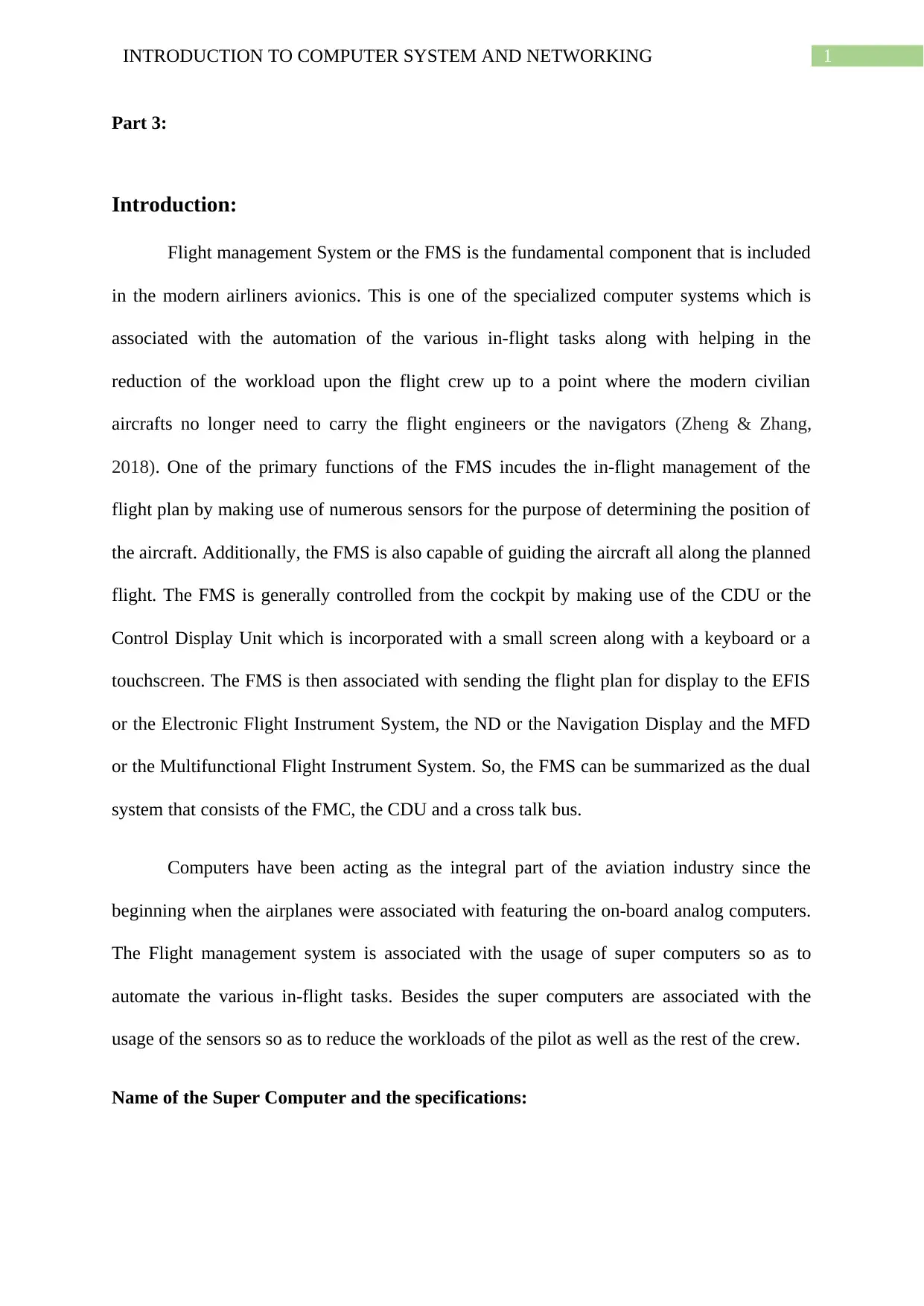
1INTRODUCTION TO COMPUTER SYSTEM AND NETWORKING
Part 3:
Introduction:
Flight management System or the FMS is the fundamental component that is included
in the modern airliners avionics. This is one of the specialized computer systems which is
associated with the automation of the various in-flight tasks along with helping in the
reduction of the workload upon the flight crew up to a point where the modern civilian
aircrafts no longer need to carry the flight engineers or the navigators (Zheng & Zhang,
2018). One of the primary functions of the FMS incudes the in-flight management of the
flight plan by making use of numerous sensors for the purpose of determining the position of
the aircraft. Additionally, the FMS is also capable of guiding the aircraft all along the planned
flight. The FMS is generally controlled from the cockpit by making use of the CDU or the
Control Display Unit which is incorporated with a small screen along with a keyboard or a
touchscreen. The FMS is then associated with sending the flight plan for display to the EFIS
or the Electronic Flight Instrument System, the ND or the Navigation Display and the MFD
or the Multifunctional Flight Instrument System. So, the FMS can be summarized as the dual
system that consists of the FMC, the CDU and a cross talk bus.
Computers have been acting as the integral part of the aviation industry since the
beginning when the airplanes were associated with featuring the on-board analog computers.
The Flight management system is associated with the usage of super computers so as to
automate the various in-flight tasks. Besides the super computers are associated with the
usage of the sensors so as to reduce the workloads of the pilot as well as the rest of the crew.
Name of the Super Computer and the specifications:
Part 3:
Introduction:
Flight management System or the FMS is the fundamental component that is included
in the modern airliners avionics. This is one of the specialized computer systems which is
associated with the automation of the various in-flight tasks along with helping in the
reduction of the workload upon the flight crew up to a point where the modern civilian
aircrafts no longer need to carry the flight engineers or the navigators (Zheng & Zhang,
2018). One of the primary functions of the FMS incudes the in-flight management of the
flight plan by making use of numerous sensors for the purpose of determining the position of
the aircraft. Additionally, the FMS is also capable of guiding the aircraft all along the planned
flight. The FMS is generally controlled from the cockpit by making use of the CDU or the
Control Display Unit which is incorporated with a small screen along with a keyboard or a
touchscreen. The FMS is then associated with sending the flight plan for display to the EFIS
or the Electronic Flight Instrument System, the ND or the Navigation Display and the MFD
or the Multifunctional Flight Instrument System. So, the FMS can be summarized as the dual
system that consists of the FMC, the CDU and a cross talk bus.
Computers have been acting as the integral part of the aviation industry since the
beginning when the airplanes were associated with featuring the on-board analog computers.
The Flight management system is associated with the usage of super computers so as to
automate the various in-flight tasks. Besides the super computers are associated with the
usage of the sensors so as to reduce the workloads of the pilot as well as the rest of the crew.
Name of the Super Computer and the specifications:
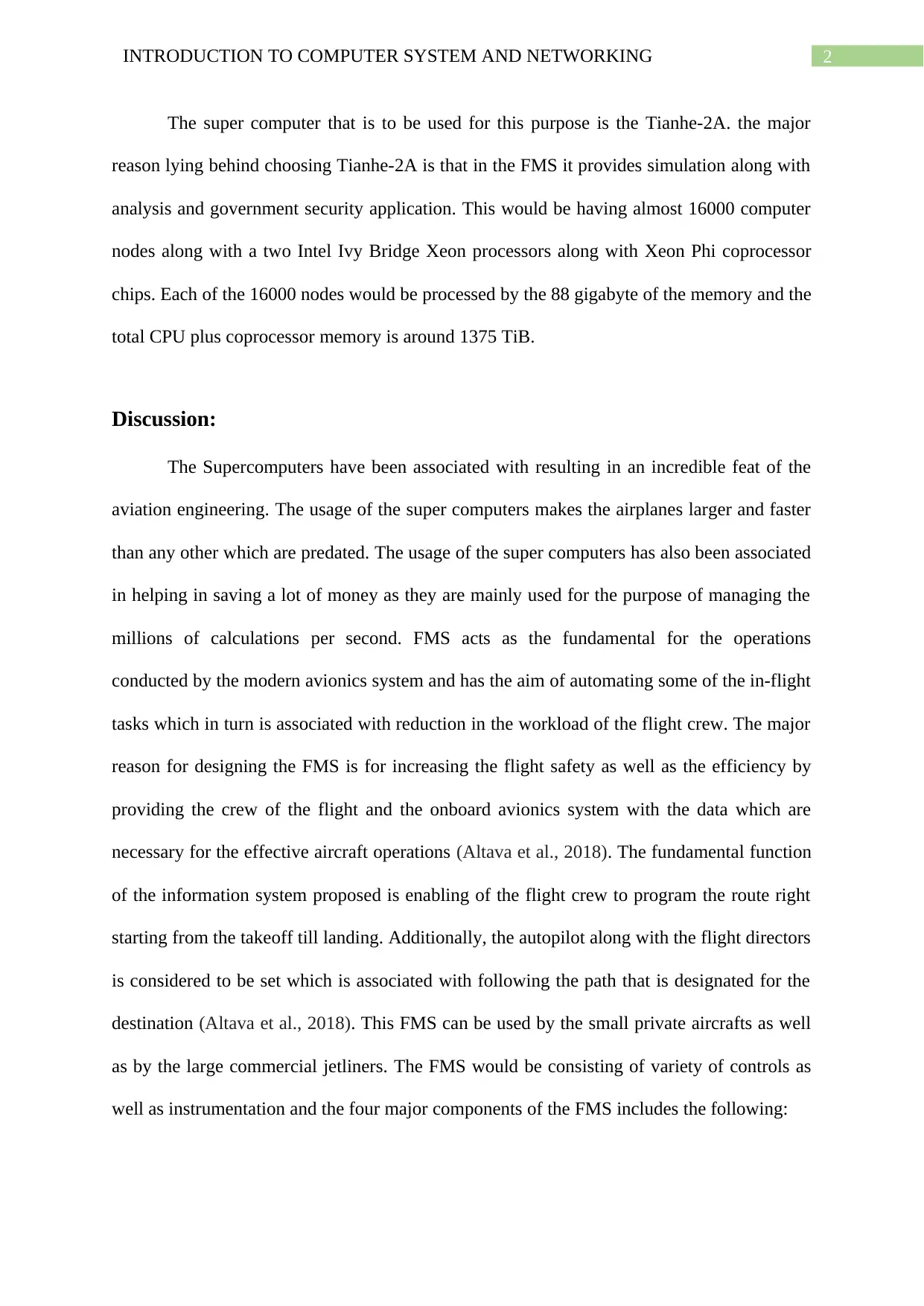
2INTRODUCTION TO COMPUTER SYSTEM AND NETWORKING
The super computer that is to be used for this purpose is the Tianhe-2A. the major
reason lying behind choosing Tianhe-2A is that in the FMS it provides simulation along with
analysis and government security application. This would be having almost 16000 computer
nodes along with a two Intel Ivy Bridge Xeon processors along with Xeon Phi coprocessor
chips. Each of the 16000 nodes would be processed by the 88 gigabyte of the memory and the
total CPU plus coprocessor memory is around 1375 TiB.
Discussion:
The Supercomputers have been associated with resulting in an incredible feat of the
aviation engineering. The usage of the super computers makes the airplanes larger and faster
than any other which are predated. The usage of the super computers has also been associated
in helping in saving a lot of money as they are mainly used for the purpose of managing the
millions of calculations per second. FMS acts as the fundamental for the operations
conducted by the modern avionics system and has the aim of automating some of the in-flight
tasks which in turn is associated with reduction in the workload of the flight crew. The major
reason for designing the FMS is for increasing the flight safety as well as the efficiency by
providing the crew of the flight and the onboard avionics system with the data which are
necessary for the effective aircraft operations (Altava et al., 2018). The fundamental function
of the information system proposed is enabling of the flight crew to program the route right
starting from the takeoff till landing. Additionally, the autopilot along with the flight directors
is considered to be set which is associated with following the path that is designated for the
destination (Altava et al., 2018). This FMS can be used by the small private aircrafts as well
as by the large commercial jetliners. The FMS would be consisting of variety of controls as
well as instrumentation and the four major components of the FMS includes the following:
The super computer that is to be used for this purpose is the Tianhe-2A. the major
reason lying behind choosing Tianhe-2A is that in the FMS it provides simulation along with
analysis and government security application. This would be having almost 16000 computer
nodes along with a two Intel Ivy Bridge Xeon processors along with Xeon Phi coprocessor
chips. Each of the 16000 nodes would be processed by the 88 gigabyte of the memory and the
total CPU plus coprocessor memory is around 1375 TiB.
Discussion:
The Supercomputers have been associated with resulting in an incredible feat of the
aviation engineering. The usage of the super computers makes the airplanes larger and faster
than any other which are predated. The usage of the super computers has also been associated
in helping in saving a lot of money as they are mainly used for the purpose of managing the
millions of calculations per second. FMS acts as the fundamental for the operations
conducted by the modern avionics system and has the aim of automating some of the in-flight
tasks which in turn is associated with reduction in the workload of the flight crew. The major
reason for designing the FMS is for increasing the flight safety as well as the efficiency by
providing the crew of the flight and the onboard avionics system with the data which are
necessary for the effective aircraft operations (Altava et al., 2018). The fundamental function
of the information system proposed is enabling of the flight crew to program the route right
starting from the takeoff till landing. Additionally, the autopilot along with the flight directors
is considered to be set which is associated with following the path that is designated for the
destination (Altava et al., 2018). This FMS can be used by the small private aircrafts as well
as by the large commercial jetliners. The FMS would be consisting of variety of controls as
well as instrumentation and the four major components of the FMS includes the following:
⊘ This is a preview!⊘
Do you want full access?
Subscribe today to unlock all pages.

Trusted by 1+ million students worldwide

3INTRODUCTION TO COMPUTER SYSTEM AND NETWORKING
The automatic Flight control or the Automatic Flight Guidance System: This are the two
systems which would be associated with the utilization of the various sensor information that
are collected by the supercomputers from the aircraft systems and besides this the systems
would also be responsible for automatic maneuver of the aircraft by making use of the mode
that would be selected by the crew members in cases if the autopilot is engaged (Ramasamy,
Sabatini & Gardi, 2015). Whenever the autopilot is disengaged the guidance commands that
would be displayed to the pilot would help in flying the aircraft manually along the path that
has been assigned.
Flight Management Computer: This mainly includes the computer system which is
associated with the utilization of a database by the super computers of the FMS which are
responsible for the facilitation of the routes which are pre-programmed and are then added to
the system by making use of the data-loader. The system is also associated with the
continuous updating of the information related to the position of the aircraft by referring to
the navigation aids that are accessible (Tian, Liu & Zhang, 2018). After this the aids which
are applicable are selected automatically at the time of updating the information.
The Auto-pilot is another feature provided by the super computers so as to be utilized for
flying the planes at longer distance by taking very small amount of help from the pilots. The
super computer of the FMS would be assisting in the taking off and landing of the airplanes
without taking assistance from humans making the entire aviation automated.
The Aircraft Navigation System: This is considered to be the integrated package that is
associated with tracking the position of the aircraft in a continuous way. This would be
featuring the GPS or the Global Positioning System and the IRS or the Inertial Reference
System data along with which the receivers that would gather the Input from the ground-
based flight navigation aids.
The automatic Flight control or the Automatic Flight Guidance System: This are the two
systems which would be associated with the utilization of the various sensor information that
are collected by the supercomputers from the aircraft systems and besides this the systems
would also be responsible for automatic maneuver of the aircraft by making use of the mode
that would be selected by the crew members in cases if the autopilot is engaged (Ramasamy,
Sabatini & Gardi, 2015). Whenever the autopilot is disengaged the guidance commands that
would be displayed to the pilot would help in flying the aircraft manually along the path that
has been assigned.
Flight Management Computer: This mainly includes the computer system which is
associated with the utilization of a database by the super computers of the FMS which are
responsible for the facilitation of the routes which are pre-programmed and are then added to
the system by making use of the data-loader. The system is also associated with the
continuous updating of the information related to the position of the aircraft by referring to
the navigation aids that are accessible (Tian, Liu & Zhang, 2018). After this the aids which
are applicable are selected automatically at the time of updating the information.
The Auto-pilot is another feature provided by the super computers so as to be utilized for
flying the planes at longer distance by taking very small amount of help from the pilots. The
super computer of the FMS would be assisting in the taking off and landing of the airplanes
without taking assistance from humans making the entire aviation automated.
The Aircraft Navigation System: This is considered to be the integrated package that is
associated with tracking the position of the aircraft in a continuous way. This would be
featuring the GPS or the Global Positioning System and the IRS or the Inertial Reference
System data along with which the receivers that would gather the Input from the ground-
based flight navigation aids.
Paraphrase This Document
Need a fresh take? Get an instant paraphrase of this document with our AI Paraphraser
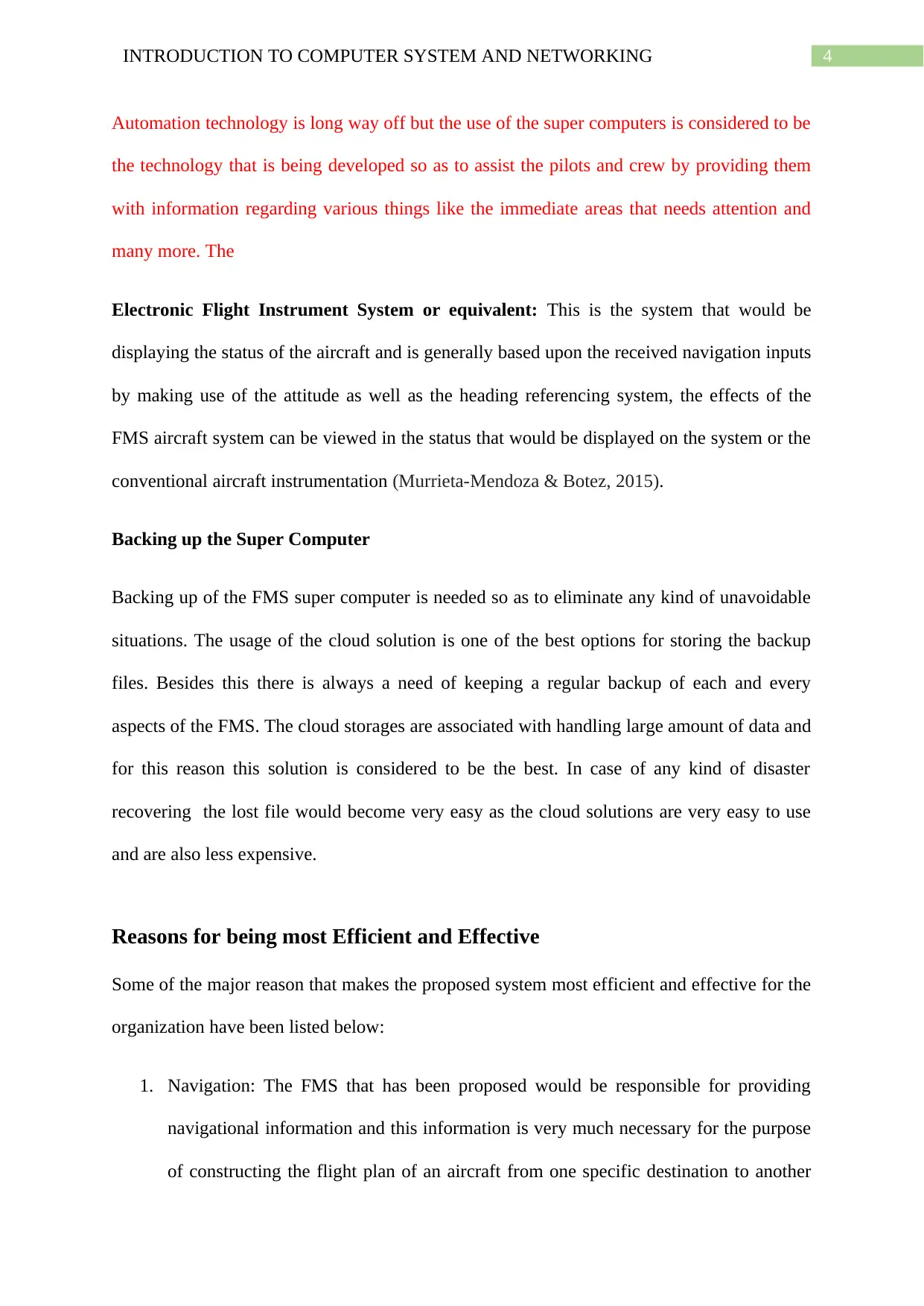
4INTRODUCTION TO COMPUTER SYSTEM AND NETWORKING
Automation technology is long way off but the use of the super computers is considered to be
the technology that is being developed so as to assist the pilots and crew by providing them
with information regarding various things like the immediate areas that needs attention and
many more. The
Electronic Flight Instrument System or equivalent: This is the system that would be
displaying the status of the aircraft and is generally based upon the received navigation inputs
by making use of the attitude as well as the heading referencing system, the effects of the
FMS aircraft system can be viewed in the status that would be displayed on the system or the
conventional aircraft instrumentation (Murrieta-Mendoza & Botez, 2015).
Backing up the Super Computer
Backing up of the FMS super computer is needed so as to eliminate any kind of unavoidable
situations. The usage of the cloud solution is one of the best options for storing the backup
files. Besides this there is always a need of keeping a regular backup of each and every
aspects of the FMS. The cloud storages are associated with handling large amount of data and
for this reason this solution is considered to be the best. In case of any kind of disaster
recovering the lost file would become very easy as the cloud solutions are very easy to use
and are also less expensive.
Reasons for being most Efficient and Effective
Some of the major reason that makes the proposed system most efficient and effective for the
organization have been listed below:
1. Navigation: The FMS that has been proposed would be responsible for providing
navigational information and this information is very much necessary for the purpose
of constructing the flight plan of an aircraft from one specific destination to another
Automation technology is long way off but the use of the super computers is considered to be
the technology that is being developed so as to assist the pilots and crew by providing them
with information regarding various things like the immediate areas that needs attention and
many more. The
Electronic Flight Instrument System or equivalent: This is the system that would be
displaying the status of the aircraft and is generally based upon the received navigation inputs
by making use of the attitude as well as the heading referencing system, the effects of the
FMS aircraft system can be viewed in the status that would be displayed on the system or the
conventional aircraft instrumentation (Murrieta-Mendoza & Botez, 2015).
Backing up the Super Computer
Backing up of the FMS super computer is needed so as to eliminate any kind of unavoidable
situations. The usage of the cloud solution is one of the best options for storing the backup
files. Besides this there is always a need of keeping a regular backup of each and every
aspects of the FMS. The cloud storages are associated with handling large amount of data and
for this reason this solution is considered to be the best. In case of any kind of disaster
recovering the lost file would become very easy as the cloud solutions are very easy to use
and are also less expensive.
Reasons for being most Efficient and Effective
Some of the major reason that makes the proposed system most efficient and effective for the
organization have been listed below:
1. Navigation: The FMS that has been proposed would be responsible for providing
navigational information and this information is very much necessary for the purpose
of constructing the flight plan of an aircraft from one specific destination to another
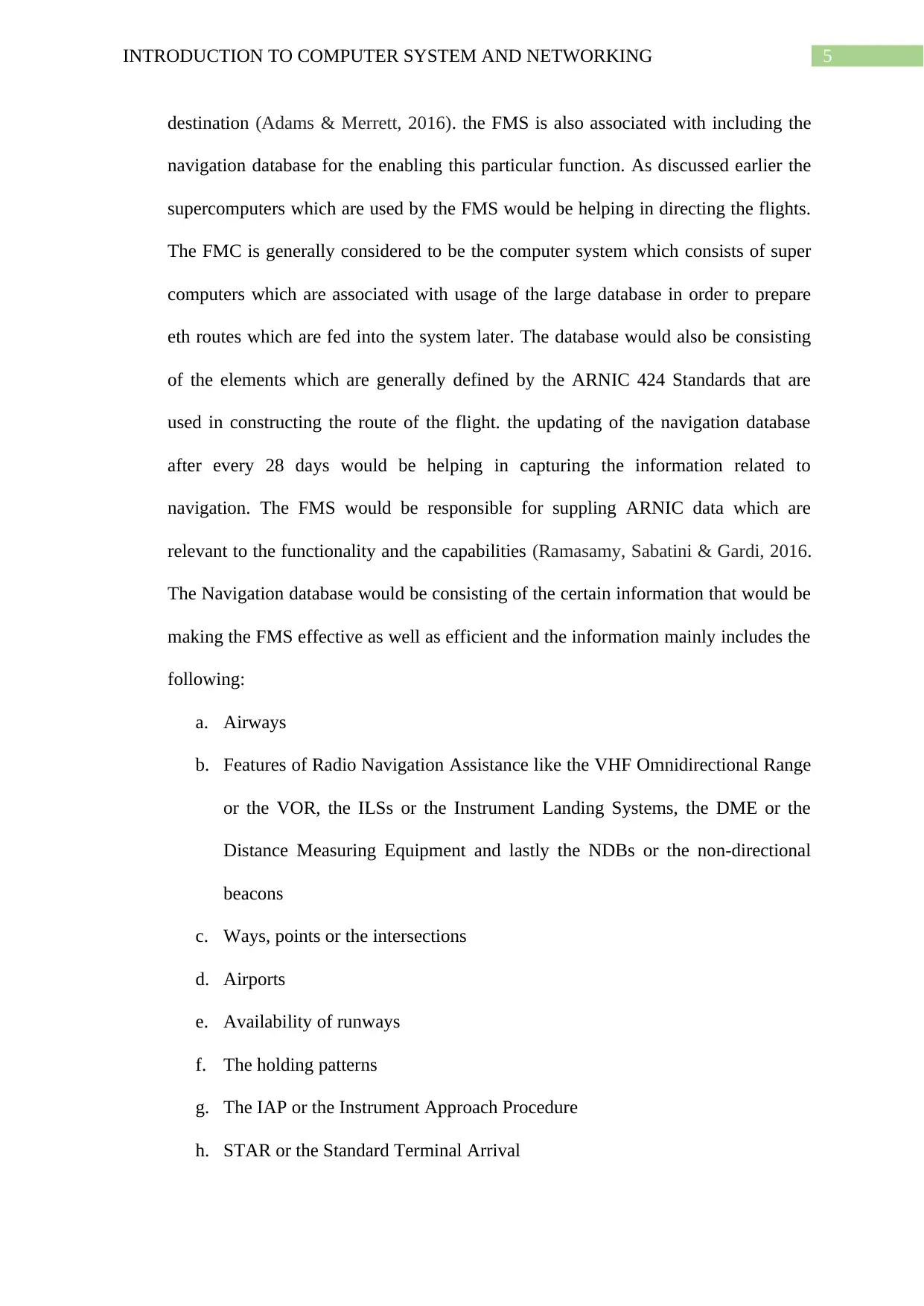
5INTRODUCTION TO COMPUTER SYSTEM AND NETWORKING
destination (Adams & Merrett, 2016). the FMS is also associated with including the
navigation database for the enabling this particular function. As discussed earlier the
supercomputers which are used by the FMS would be helping in directing the flights.
The FMC is generally considered to be the computer system which consists of super
computers which are associated with usage of the large database in order to prepare
eth routes which are fed into the system later. The database would also be consisting
of the elements which are generally defined by the ARNIC 424 Standards that are
used in constructing the route of the flight. the updating of the navigation database
after every 28 days would be helping in capturing the information related to
navigation. The FMS would be responsible for suppling ARNIC data which are
relevant to the functionality and the capabilities (Ramasamy, Sabatini & Gardi, 2016.
The Navigation database would be consisting of the certain information that would be
making the FMS effective as well as efficient and the information mainly includes the
following:
a. Airways
b. Features of Radio Navigation Assistance like the VHF Omnidirectional Range
or the VOR, the ILSs or the Instrument Landing Systems, the DME or the
Distance Measuring Equipment and lastly the NDBs or the non-directional
beacons
c. Ways, points or the intersections
d. Airports
e. Availability of runways
f. The holding patterns
g. The IAP or the Instrument Approach Procedure
h. STAR or the Standard Terminal Arrival
destination (Adams & Merrett, 2016). the FMS is also associated with including the
navigation database for the enabling this particular function. As discussed earlier the
supercomputers which are used by the FMS would be helping in directing the flights.
The FMC is generally considered to be the computer system which consists of super
computers which are associated with usage of the large database in order to prepare
eth routes which are fed into the system later. The database would also be consisting
of the elements which are generally defined by the ARNIC 424 Standards that are
used in constructing the route of the flight. the updating of the navigation database
after every 28 days would be helping in capturing the information related to
navigation. The FMS would be responsible for suppling ARNIC data which are
relevant to the functionality and the capabilities (Ramasamy, Sabatini & Gardi, 2016.
The Navigation database would be consisting of the certain information that would be
making the FMS effective as well as efficient and the information mainly includes the
following:
a. Airways
b. Features of Radio Navigation Assistance like the VHF Omnidirectional Range
or the VOR, the ILSs or the Instrument Landing Systems, the DME or the
Distance Measuring Equipment and lastly the NDBs or the non-directional
beacons
c. Ways, points or the intersections
d. Airports
e. Availability of runways
f. The holding patterns
g. The IAP or the Instrument Approach Procedure
h. STAR or the Standard Terminal Arrival
⊘ This is a preview!⊘
Do you want full access?
Subscribe today to unlock all pages.

Trusted by 1+ million students worldwide

6INTRODUCTION TO COMPUTER SYSTEM AND NETWORKING
i. SID or the Standard instrument departure
The plan for the flight is generally determined on the ground before the departure by
the professional dispatcher for airliners or the by the pilots in case of small airplanes.
The typical directing of this into the FMS that is selected from the library of the
common flight routes or are generally entered manually by making use of the ACARS
datalink with the airplane dispatch center. Besides this all other relevant data related
to management of the flight like the weight of the fuel or the gross weight would be
entered into the FMS before taking off (Moallemi & Towhidnejad, 2016. A pilot
might be associated with the usage of the FMS for the purpose of altering the flight
plan if it is necessary. The flight plan would be presenting itself on the navigation
display of the EFIS in the form of magnetic lines.
2. Determining of the position: The FMS system is having the primary objective of
determining the aircrafts position while in flight along with assessing the accuracy of
this type of education (Adams & Merrett, 2016). The FMS Is associated with the
usage of a single sensor along with a GPS for the purpose of calculating the position
along with different sensors which includes the VORs for the purpose of obtaining
and validating the information that are precise in nature. The navigation system is
considered to be one of the integrated packages of the supercomputers which would
be assisting in the process of calculating the position of the aircraft. This might be
consisting of the IRS or the Inertial Reference System and the GPS or the Global
Positioning system inputs along with the receivers so as to receive aids that are
ground based. Some of the most common integrated sensors that helps in increasing
the efficiency of the system includes the following:
i. SID or the Standard instrument departure
The plan for the flight is generally determined on the ground before the departure by
the professional dispatcher for airliners or the by the pilots in case of small airplanes.
The typical directing of this into the FMS that is selected from the library of the
common flight routes or are generally entered manually by making use of the ACARS
datalink with the airplane dispatch center. Besides this all other relevant data related
to management of the flight like the weight of the fuel or the gross weight would be
entered into the FMS before taking off (Moallemi & Towhidnejad, 2016. A pilot
might be associated with the usage of the FMS for the purpose of altering the flight
plan if it is necessary. The flight plan would be presenting itself on the navigation
display of the EFIS in the form of magnetic lines.
2. Determining of the position: The FMS system is having the primary objective of
determining the aircrafts position while in flight along with assessing the accuracy of
this type of education (Adams & Merrett, 2016). The FMS Is associated with the
usage of a single sensor along with a GPS for the purpose of calculating the position
along with different sensors which includes the VORs for the purpose of obtaining
and validating the information that are precise in nature. The navigation system is
considered to be one of the integrated packages of the supercomputers which would
be assisting in the process of calculating the position of the aircraft. This might be
consisting of the IRS or the Inertial Reference System and the GPS or the Global
Positioning system inputs along with the receivers so as to receive aids that are
ground based. Some of the most common integrated sensors that helps in increasing
the efficiency of the system includes the following:
Paraphrase This Document
Need a fresh take? Get an instant paraphrase of this document with our AI Paraphraser
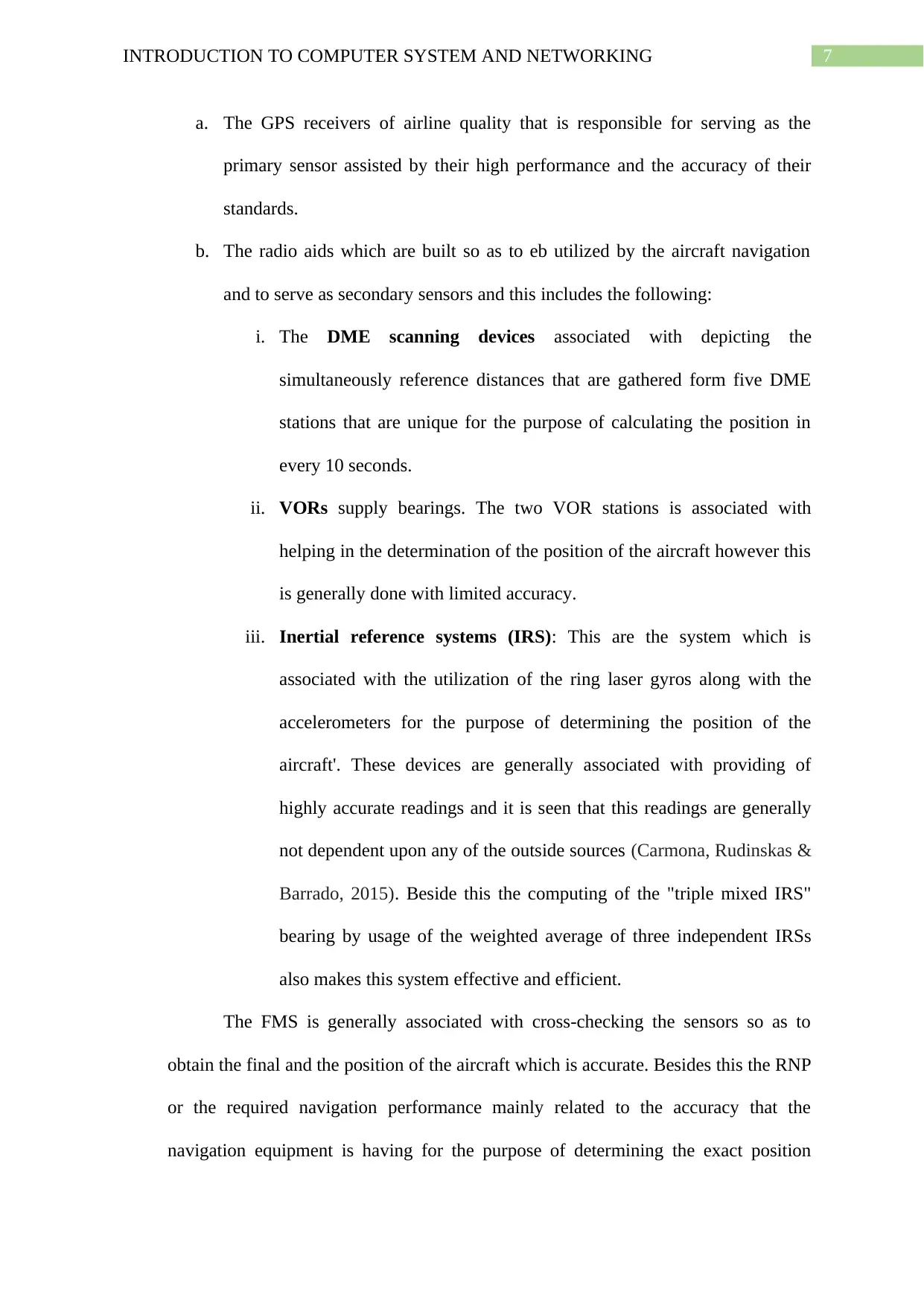
7INTRODUCTION TO COMPUTER SYSTEM AND NETWORKING
a. The GPS receivers of airline quality that is responsible for serving as the
primary sensor assisted by their high performance and the accuracy of their
standards.
b. The radio aids which are built so as to eb utilized by the aircraft navigation
and to serve as secondary sensors and this includes the following:
i. The DME scanning devices associated with depicting the
simultaneously reference distances that are gathered form five DME
stations that are unique for the purpose of calculating the position in
every 10 seconds.
ii. VORs supply bearings. The two VOR stations is associated with
helping in the determination of the position of the aircraft however this
is generally done with limited accuracy.
iii. Inertial reference systems (IRS): This are the system which is
associated with the utilization of the ring laser gyros along with the
accelerometers for the purpose of determining the position of the
aircraft'. These devices are generally associated with providing of
highly accurate readings and it is seen that this readings are generally
not dependent upon any of the outside sources (Carmona, Rudinskas &
Barrado, 2015). Beside this the computing of the "triple mixed IRS"
bearing by usage of the weighted average of three independent IRSs
also makes this system effective and efficient.
The FMS is generally associated with cross-checking the sensors so as to
obtain the final and the position of the aircraft which is accurate. Besides this the RNP
or the required navigation performance mainly related to the accuracy that the
navigation equipment is having for the purpose of determining the exact position
a. The GPS receivers of airline quality that is responsible for serving as the
primary sensor assisted by their high performance and the accuracy of their
standards.
b. The radio aids which are built so as to eb utilized by the aircraft navigation
and to serve as secondary sensors and this includes the following:
i. The DME scanning devices associated with depicting the
simultaneously reference distances that are gathered form five DME
stations that are unique for the purpose of calculating the position in
every 10 seconds.
ii. VORs supply bearings. The two VOR stations is associated with
helping in the determination of the position of the aircraft however this
is generally done with limited accuracy.
iii. Inertial reference systems (IRS): This are the system which is
associated with the utilization of the ring laser gyros along with the
accelerometers for the purpose of determining the position of the
aircraft'. These devices are generally associated with providing of
highly accurate readings and it is seen that this readings are generally
not dependent upon any of the outside sources (Carmona, Rudinskas &
Barrado, 2015). Beside this the computing of the "triple mixed IRS"
bearing by usage of the weighted average of three independent IRSs
also makes this system effective and efficient.
The FMS is generally associated with cross-checking the sensors so as to
obtain the final and the position of the aircraft which is accurate. Besides this the RNP
or the required navigation performance mainly related to the accuracy that the
navigation equipment is having for the purpose of determining the exact position
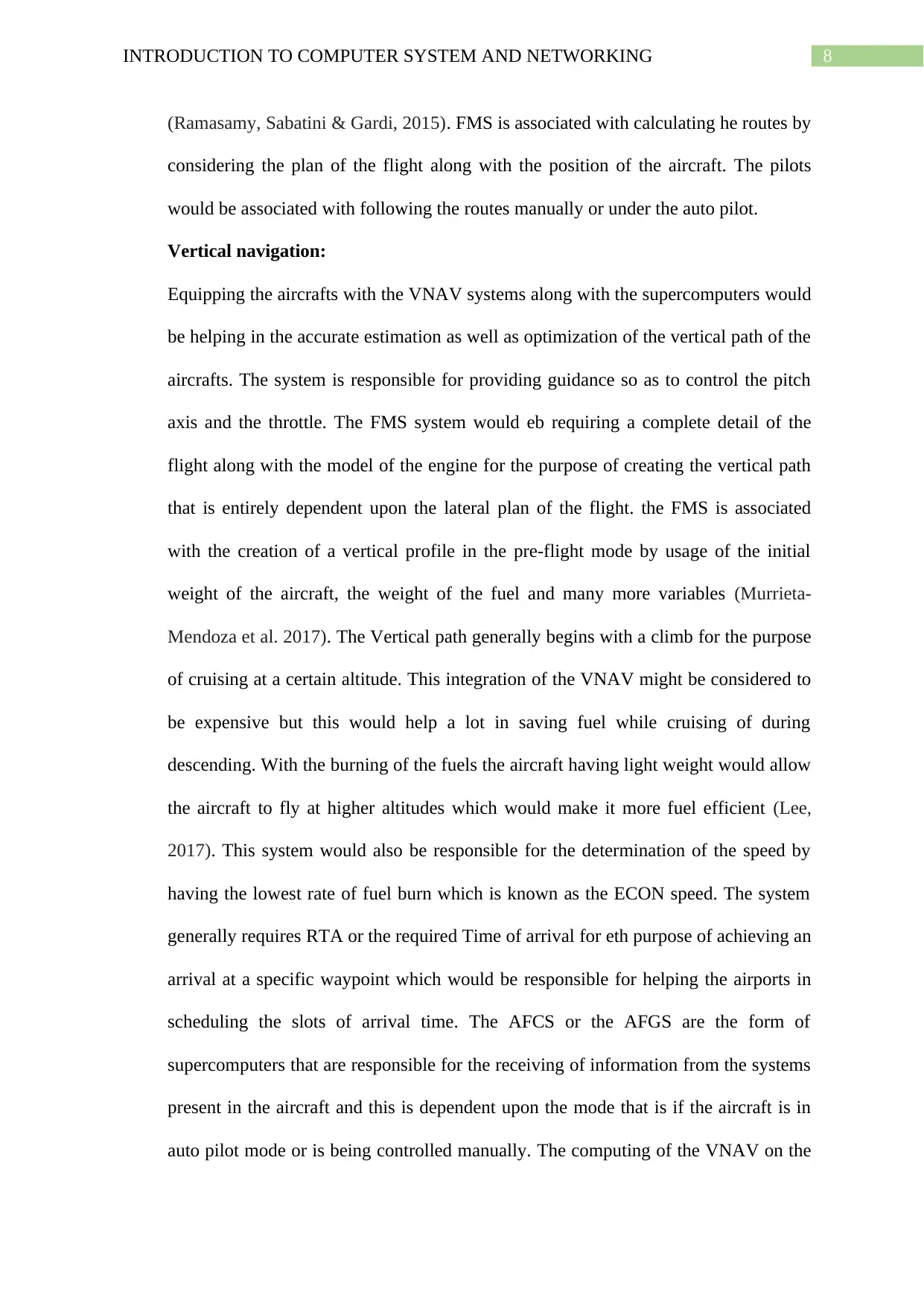
8INTRODUCTION TO COMPUTER SYSTEM AND NETWORKING
(Ramasamy, Sabatini & Gardi, 2015). FMS is associated with calculating he routes by
considering the plan of the flight along with the position of the aircraft. The pilots
would be associated with following the routes manually or under the auto pilot.
Vertical navigation:
Equipping the aircrafts with the VNAV systems along with the supercomputers would
be helping in the accurate estimation as well as optimization of the vertical path of the
aircrafts. The system is responsible for providing guidance so as to control the pitch
axis and the throttle. The FMS system would eb requiring a complete detail of the
flight along with the model of the engine for the purpose of creating the vertical path
that is entirely dependent upon the lateral plan of the flight. the FMS is associated
with the creation of a vertical profile in the pre-flight mode by usage of the initial
weight of the aircraft, the weight of the fuel and many more variables (Murrieta-
Mendoza et al. 2017). The Vertical path generally begins with a climb for the purpose
of cruising at a certain altitude. This integration of the VNAV might be considered to
be expensive but this would help a lot in saving fuel while cruising of during
descending. With the burning of the fuels the aircraft having light weight would allow
the aircraft to fly at higher altitudes which would make it more fuel efficient (Lee,
2017). This system would also be responsible for the determination of the speed by
having the lowest rate of fuel burn which is known as the ECON speed. The system
generally requires RTA or the required Time of arrival for eth purpose of achieving an
arrival at a specific waypoint which would be responsible for helping the airports in
scheduling the slots of arrival time. The AFCS or the AFGS are the form of
supercomputers that are responsible for the receiving of information from the systems
present in the aircraft and this is dependent upon the mode that is if the aircraft is in
auto pilot mode or is being controlled manually. The computing of the VNAV on the
(Ramasamy, Sabatini & Gardi, 2015). FMS is associated with calculating he routes by
considering the plan of the flight along with the position of the aircraft. The pilots
would be associated with following the routes manually or under the auto pilot.
Vertical navigation:
Equipping the aircrafts with the VNAV systems along with the supercomputers would
be helping in the accurate estimation as well as optimization of the vertical path of the
aircrafts. The system is responsible for providing guidance so as to control the pitch
axis and the throttle. The FMS system would eb requiring a complete detail of the
flight along with the model of the engine for the purpose of creating the vertical path
that is entirely dependent upon the lateral plan of the flight. the FMS is associated
with the creation of a vertical profile in the pre-flight mode by usage of the initial
weight of the aircraft, the weight of the fuel and many more variables (Murrieta-
Mendoza et al. 2017). The Vertical path generally begins with a climb for the purpose
of cruising at a certain altitude. This integration of the VNAV might be considered to
be expensive but this would help a lot in saving fuel while cruising of during
descending. With the burning of the fuels the aircraft having light weight would allow
the aircraft to fly at higher altitudes which would make it more fuel efficient (Lee,
2017). This system would also be responsible for the determination of the speed by
having the lowest rate of fuel burn which is known as the ECON speed. The system
generally requires RTA or the required Time of arrival for eth purpose of achieving an
arrival at a specific waypoint which would be responsible for helping the airports in
scheduling the slots of arrival time. The AFCS or the AFGS are the form of
supercomputers that are responsible for the receiving of information from the systems
present in the aircraft and this is dependent upon the mode that is if the aircraft is in
auto pilot mode or is being controlled manually. The computing of the VNAV on the
⊘ This is a preview!⊘
Do you want full access?
Subscribe today to unlock all pages.

Trusted by 1+ million students worldwide
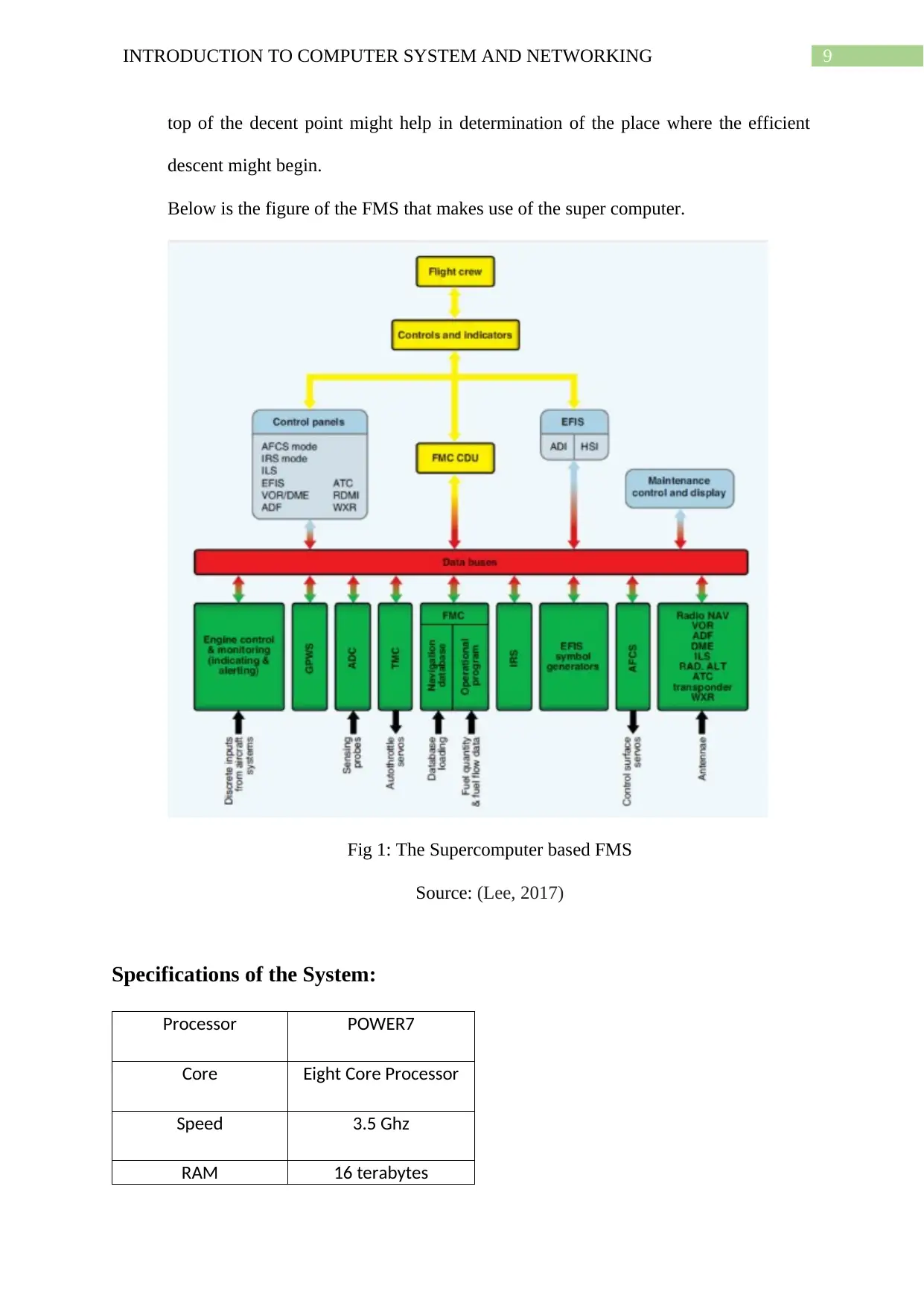
9INTRODUCTION TO COMPUTER SYSTEM AND NETWORKING
top of the decent point might help in determination of the place where the efficient
descent might begin.
Below is the figure of the FMS that makes use of the super computer.
Fig 1: The Supercomputer based FMS
Source: (Lee, 2017)
Specifications of the System:
Processor POWER7
Core Eight Core Processor
Speed 3.5 Ghz
RAM 16 terabytes
top of the decent point might help in determination of the place where the efficient
descent might begin.
Below is the figure of the FMS that makes use of the super computer.
Fig 1: The Supercomputer based FMS
Source: (Lee, 2017)
Specifications of the System:
Processor POWER7
Core Eight Core Processor
Speed 3.5 Ghz
RAM 16 terabytes
Paraphrase This Document
Need a fresh take? Get an instant paraphrase of this document with our AI Paraphraser
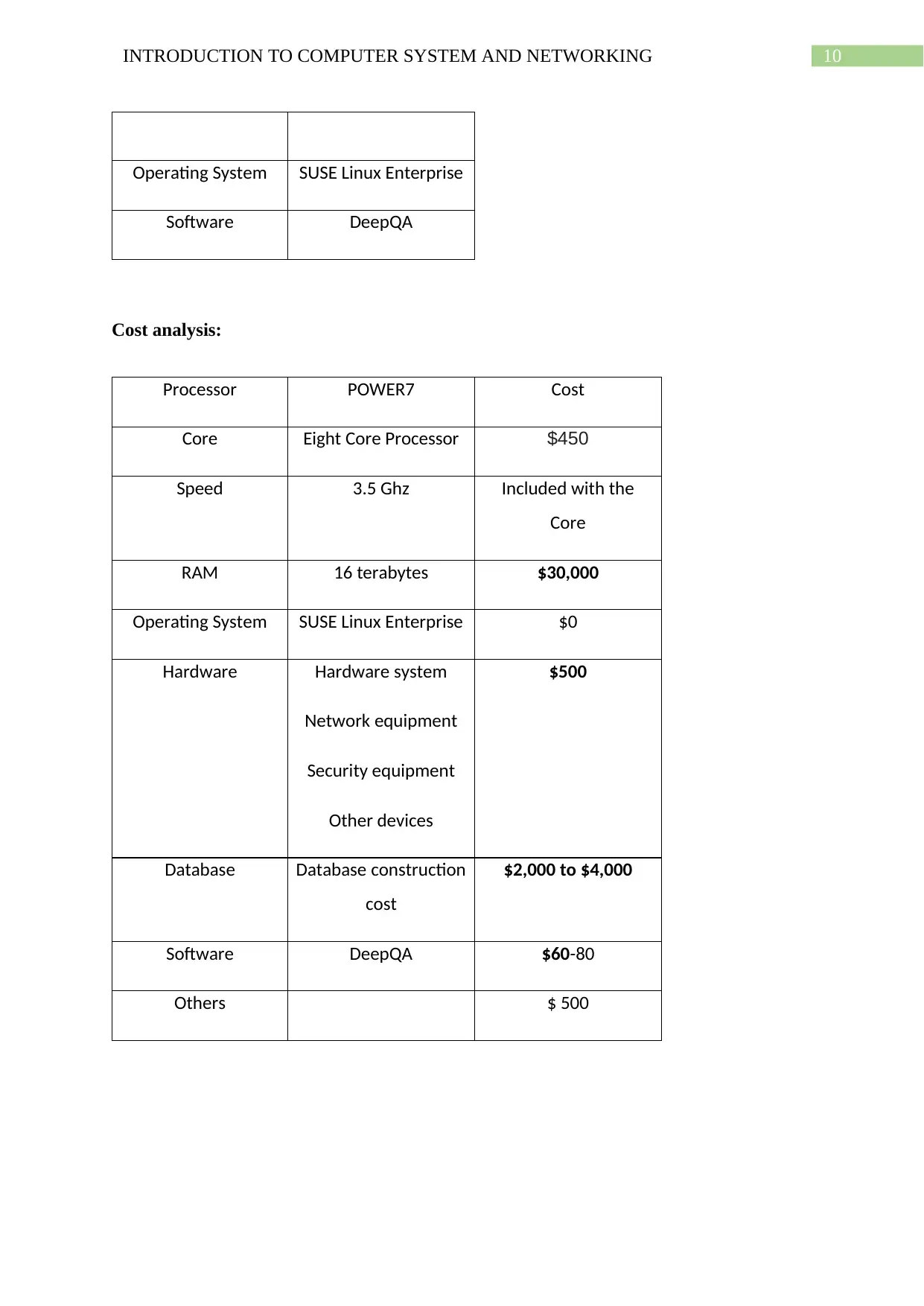
10INTRODUCTION TO COMPUTER SYSTEM AND NETWORKING
Operating System SUSE Linux Enterprise
Software DeepQA
Cost analysis:
Processor POWER7 Cost
Core Eight Core Processor $450
Speed 3.5 Ghz Included with the
Core
RAM 16 terabytes $30,000
Operating System SUSE Linux Enterprise $0
Hardware Hardware system
Network equipment
Security equipment
Other devices
$500
Database Database construction
cost
$2,000 to $4,000
Software DeepQA $60-80
Others $ 500
Operating System SUSE Linux Enterprise
Software DeepQA
Cost analysis:
Processor POWER7 Cost
Core Eight Core Processor $450
Speed 3.5 Ghz Included with the
Core
RAM 16 terabytes $30,000
Operating System SUSE Linux Enterprise $0
Hardware Hardware system
Network equipment
Security equipment
Other devices
$500
Database Database construction
cost
$2,000 to $4,000
Software DeepQA $60-80
Others $ 500
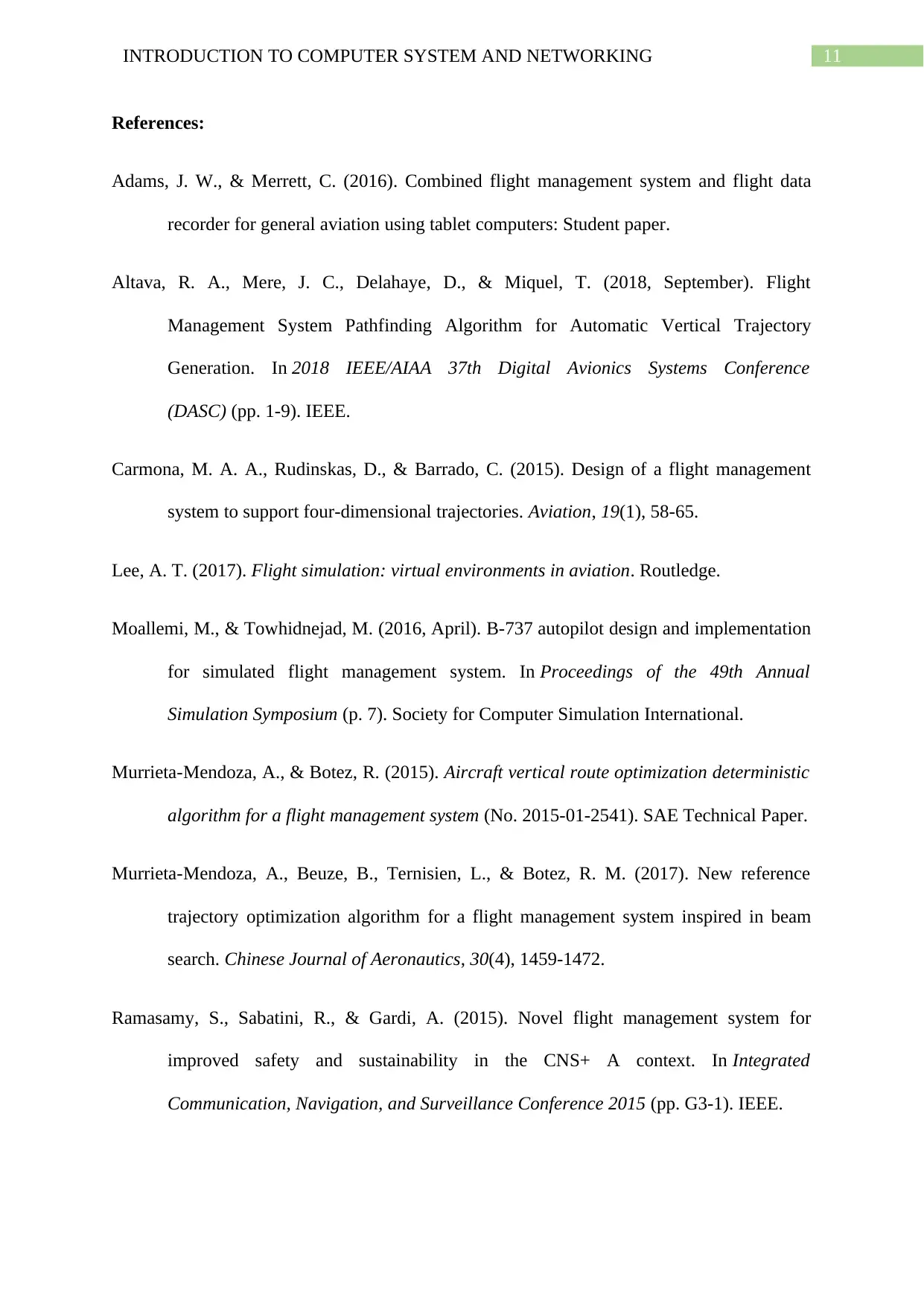
11INTRODUCTION TO COMPUTER SYSTEM AND NETWORKING
References:
Adams, J. W., & Merrett, C. (2016). Combined flight management system and flight data
recorder for general aviation using tablet computers: Student paper.
Altava, R. A., Mere, J. C., Delahaye, D., & Miquel, T. (2018, September). Flight
Management System Pathfinding Algorithm for Automatic Vertical Trajectory
Generation. In 2018 IEEE/AIAA 37th Digital Avionics Systems Conference
(DASC) (pp. 1-9). IEEE.
Carmona, M. A. A., Rudinskas, D., & Barrado, C. (2015). Design of a flight management
system to support four-dimensional trajectories. Aviation, 19(1), 58-65.
Lee, A. T. (2017). Flight simulation: virtual environments in aviation. Routledge.
Moallemi, M., & Towhidnejad, M. (2016, April). B-737 autopilot design and implementation
for simulated flight management system. In Proceedings of the 49th Annual
Simulation Symposium (p. 7). Society for Computer Simulation International.
Murrieta-Mendoza, A., & Botez, R. (2015). Aircraft vertical route optimization deterministic
algorithm for a flight management system (No. 2015-01-2541). SAE Technical Paper.
Murrieta-Mendoza, A., Beuze, B., Ternisien, L., & Botez, R. M. (2017). New reference
trajectory optimization algorithm for a flight management system inspired in beam
search. Chinese Journal of Aeronautics, 30(4), 1459-1472.
Ramasamy, S., Sabatini, R., & Gardi, A. (2015). Novel flight management system for
improved safety and sustainability in the CNS+ A context. In Integrated
Communication, Navigation, and Surveillance Conference 2015 (pp. G3-1). IEEE.
References:
Adams, J. W., & Merrett, C. (2016). Combined flight management system and flight data
recorder for general aviation using tablet computers: Student paper.
Altava, R. A., Mere, J. C., Delahaye, D., & Miquel, T. (2018, September). Flight
Management System Pathfinding Algorithm for Automatic Vertical Trajectory
Generation. In 2018 IEEE/AIAA 37th Digital Avionics Systems Conference
(DASC) (pp. 1-9). IEEE.
Carmona, M. A. A., Rudinskas, D., & Barrado, C. (2015). Design of a flight management
system to support four-dimensional trajectories. Aviation, 19(1), 58-65.
Lee, A. T. (2017). Flight simulation: virtual environments in aviation. Routledge.
Moallemi, M., & Towhidnejad, M. (2016, April). B-737 autopilot design and implementation
for simulated flight management system. In Proceedings of the 49th Annual
Simulation Symposium (p. 7). Society for Computer Simulation International.
Murrieta-Mendoza, A., & Botez, R. (2015). Aircraft vertical route optimization deterministic
algorithm for a flight management system (No. 2015-01-2541). SAE Technical Paper.
Murrieta-Mendoza, A., Beuze, B., Ternisien, L., & Botez, R. M. (2017). New reference
trajectory optimization algorithm for a flight management system inspired in beam
search. Chinese Journal of Aeronautics, 30(4), 1459-1472.
Ramasamy, S., Sabatini, R., & Gardi, A. (2015). Novel flight management system for
improved safety and sustainability in the CNS+ A context. In Integrated
Communication, Navigation, and Surveillance Conference 2015 (pp. G3-1). IEEE.
⊘ This is a preview!⊘
Do you want full access?
Subscribe today to unlock all pages.

Trusted by 1+ million students worldwide
1 out of 13
Your All-in-One AI-Powered Toolkit for Academic Success.
+13062052269
info@desklib.com
Available 24*7 on WhatsApp / Email
![[object Object]](/_next/static/media/star-bottom.7253800d.svg)
Unlock your academic potential
Copyright © 2020–2025 A2Z Services. All Rights Reserved. Developed and managed by ZUCOL.
